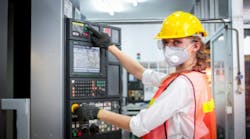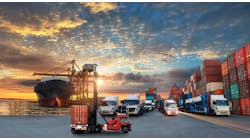By Sean Hennessy, CEO of TRADESAFE
The world of industrial safety-equipment providers is a traditional and entrenched group that includes major international companies and household name brands. Making inroads into this marketplace is tough, and any company looking to do so has to provide what the household names lack—quality at a reasonable price, easy methods of purchase, and top-notch customer service that follows the sun.
This article will discuss the new expectations of the industrial safety-equipment marketplace and some strategies for competing against the established vendors. This article will also review the techniques and programs put in place to create a seamless customer experience and why this niche industry needed to make changes to evolve in the post-pandemic retail marketplace.
The global industrial safety equipment marketplace was valued at $77.36B in 2020. As COVID-19 struck, the demand for personal protective equipment (PPE) skyrocketed by 152.8% and is projected to increase by 8.78% by 2026. There will always be a demand for PPE as it serves to protect user from various safety and health hazards in the workplace. It is also in employers’ interest to invest in PPE as it could cut potential expenditures on lost manufacturing time and medical compensation.
Driving factors for growth
The growth of the industrial safety-equipment marketplace is fueled by increased awareness of workplace safety. PPE programs and equipment are mandated and implemented by the US Department of Labor and Occupational Safety and Health Administration (OSHA) in some states. As such, workers must wear equipment such as protective clothing, helmets, earplugs, goggles, gloves, and protective footwear. They are also expected to be fully aware of emergency exits and protocols in cases of injuries.
The industry is also fueled by the increasing number of workplace-related accidents and how these are effectively remedied by PPE. For example, a study by the International Association of Oil and Gas Producers (IOGP) revealed that fatalities in the oil & gas industry were reduced by 8% with the simple implementation of protective gear.
OSHA stresses the correct usage of protective equipment. The equipment must also be compliant with their standards to be fully effective. As such, workplaces shifted to brands that were certified and tested. These workplaces are also periodically monitored to ensure that they are upholding a healthy and safe work environment that protects employee wellness.
The construction and infrastructure industry is constantly growing, especially in the US, India, and China. Both residential and commercial areas need construction for area development. This meant that occupational hazards were also increasing. According to OSHA, the construction industry alone accounts for 22% of the deaths in the sector.
OSHA has identified that falls are the leading cause of both fatal and non-fatal injuries. Out of 100,000 fall-related injuries annually, 100 to 200 lead to death. As such, workers are advised to wear the appropriate footwear that is puncture-resistant and has non-slip soles that prevent slippage.
In conclusion, stricter safety policies and the number of fatalities contribute to the rising demand for industrial safety equipment. This will lead to market growth and significantly improve worker safety.
Strategies for evolution
The industrial safety-equipment niche is spearheaded by major international companies and household name brands. This does not mean that newer PPE and safety companies cannot penetrate the market and make a name for themselves. There are gaps in the market that they can fill to cater to demands and to improve the overall consumer experience and safety.
First, vendors may focus on innovations that yield lighter and higher-quality protective gear. There is a demand for PPE made of premium-quality materials that provide improved safety, comfort, durability, and even aesthetics.
Second, companies may capitalize on the rising demand for contract-based manufacturing of industrial-safety equipment. This is particularly evident in the developed economies of Western Europe and North America. Manufacturers must improve technical support and present reasonable quotes and production times for products so that they become favorable options for private-label manufacturing.
Third, companies must explore demands that are exclusive to certain types of PPE and general safety products. For example, there will be a steady demand for protective gloves in food processing, oil & gas, metal fabrication, and construction industries. This is due to the health risks linked to handling corrosive and warm objects. Protective clothing is the second largest in-demand protective equipment. This is due to the high-performing protection it provides against extreme working conditions. Protective footwear is projected to grow, as it is highly effective in reducing foot injuries that may be caused by electric shock, heavy machinery, and foot impact. There is also a steady demand for respiratory protective equipment to shield workers from chemicals, hazardous gases, vapors, and even pathogens.
Lastly, companies may shift their suppliers and manufacturers to something more accessible. China originally led the PPE export sphere, but private companies explored other exporters in order to cater to immediate demands in their respective regions.
Emphasis on customer satisfaction
Traditionally, or specifically, during the pre-COVID era, business-to-business transactions were guilty of certain pitfalls. For one, most suppliers from China primarily communicated through WeChat and other social media applications. This posed communication issues between the vendor and their clients. Procurement became more difficult, and transactions were delayed due to unresponsiveness and miscommunication.
As the pandemic hit and the demand for PPEs shot up, there was also an increase in fraudulent activities. These activities include the sale of counterfeit items or equipment that didn’t qualify for industry standards. Many of the manufacturers, not used to dealing with retail sales, went around all their typical resellers and attempted to sell direct. Doing this created massive quality issues and often over-promising the performance of the products. These false-advertisement tactics made the customers lose trust in parts of the marketplace. It exposed a simple truth in the supply chain—manufacturers, especially ones in China, often have a different understanding of quality, which opens the door for the brand or retailer to add value by controlling these problems and improving what gets delivered to the customer.
These instances just go to show that there is plenty of room for improvement. For new vendors to compete, they must prioritize customer satisfaction above everything else. One may start by improving communication with the client by manning the customer service hotline 24/7 and being more responsive. The ability to quickly and professionally respond to customer queries gives a competitive edge over the rest. This does not only pertain to emails or phone calls. The business must be responsive on all platforms, including social media.
Next, new companies can focus on establishing credibility and building rapport with their target audience. This can be accomplished by taking the time to produce high-quality and value-adding content in order to appear like an entity with authority in the niche. These types of content include photos, videos, and articles. All of the marketing material must be aligned with the brand image and message.
Third, new B2B brands can increase their market share by eliminating distributors and directly conducting sales themselves. The brand may become a direct-to-user brand for a higher profit margin. The brand may generate PPE leads that directly tap into its target demographic to create direct sales.
Lastly, the brand must cater to customers' instant gratification. The speed of the fulfillment process makes all the difference in whether or not a customer will purchase from your store. The pandemic has changed the eCommerce sphere and online shopping became the norm. Customer shopping behavioral trends dictate that 80% of online shoppers have lower loyalty to brands. Customers have so many options, so they are more likely to go for the business that provides them with a seamless customer experience. It is essential now more than ever to improve all aspects of the business to gain their loyalty.
Household PPE brands are established enough to operate with their respective warehouses and delivery systems. New brands can keep up by taking advantage of contract-fulfillment centers such as Amazon to quickly get the products delivered to the customers.
Conclusion
Additional planning and nuanced strategies are required for successful inroads into this marketplace. Companies must stray from substandard quality or poorly duplicated products as this could be detrimental to the brand image and to the user’s safety. Furthermore, the industrial-safety equipment must survive rigorous testing, comply with industry standards, and be priced competitively.


